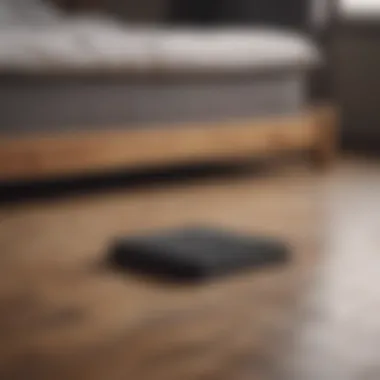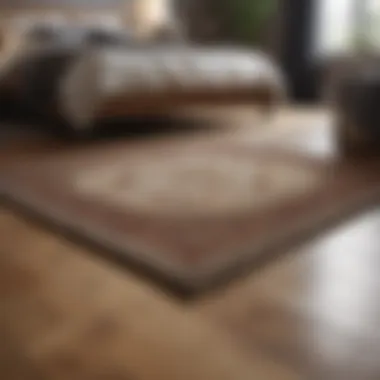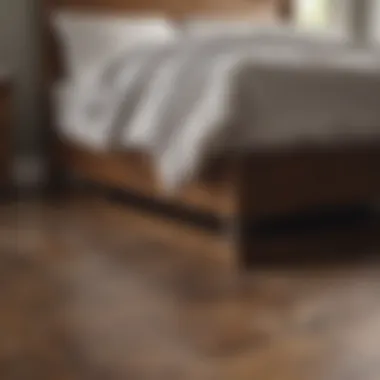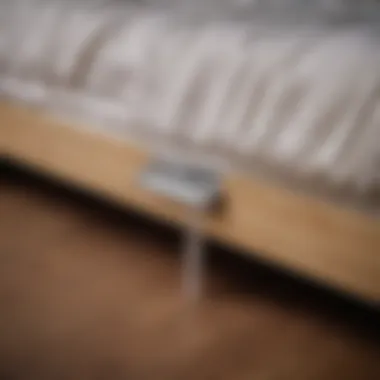Effective Strategies to Prevent Bed Sliding on Wood Floors


Intro
Bed sliding on wood floors is a common issue many homeowners face. This not only affects comfort but can also pose safety risks. Given that wood flooring is a popular choice for its aesthetic appeal and functionality, ensuring that furniture, especially beds, remains stable is essential. This article will outline practical strategies aimed at preventing bed sliding on wood floors, focusing on solutions that do not damage the flooring.
Understanding why beds slide is the first step in solving the problem. Factors can include the design of the bed frame, the weight distribution, or even the kind of flooring material used. This guide will explore effective solutions, ranging from simple adjustments to specialized products that enhance bed stability. By applying these strategies, homeowners can maintain a safe and comfortable sleep environment.
Design Inspirations
Design is not just about aesthetics; it also plays a key role in functionality. When it comes to preventing bed sliding, certain design choices can make a significant difference. Choosing a bed frame with a larger base or non-slip features can contribute to stability.
Trending Styles
In recent years, there has been a shift towards minimalistic and functional designs. Low-profile beds tend to blend seamlessly with wood floors, reducing the visual effect of any sliding. Frames that incorporate features like built-in rubber grips can also be beneficial. Look for designs that emphasize weight distribution effectively, which can minimize the chances of movement.
Color Palettes
While functionality is crucial, aesthetic values should not be overlooked. Selecting colors that complement wood flooring helps create a cohesive look. Neutral palettes, such as whites, grays, and browns, can draw attention away from minor sliding issues. Additionally, choosing darker shades can conceal potential scuff marks that may occur if the bed slides slightly.
Maintenance and Upkeep
Regular maintenance is vital for both the bed and the flooring beneath it. Keeping both clean can enhance their performance and longevity.
Seasonal Maintenance Checklist
- Inspect Bed Frame: Ensure all screws and connections are tight.
- Check for Wear: Look for wear on pads or rubber grips.
- Floor Inspection: Check for scratches or damage to the wood floor.
Cleaning and Organization Tips
- When cleaning, use products that do not leave behind residues, as sticky surfaces can attract dust and debris.
- Consider rearranging furniture periodically to optimize space while maintaining stability.
"Stability in furniture not only enhances the room's decor; it significantly enhances safety."
By adapting design choices and regularly maintaining both the bed and floor, homeowners can ensure that their sleeping space remains both stylish and functional. This thoughtful approach can mitigate the frustration of constant adjustments and offer a sense of peace in one's living environment.
Preamble
Preventing beds from sliding on wood floors is not just a matter of aesthetics but also one of safety and comfort. This phenomenon can be a source of frustration for homeowners, particularly those aiming for a stable sleeping environment. Wood floors, while visually appealing, provide little grip for furniture such as beds, leading to potential hazards. The aim of this article is to delve into practical strategies that address this common issue and to highlight the importance of maintaining stability in one’s sleeping arrangements.
The significance of this topic extends beyond mere inconvenience. A sliding bed can detract from a good night's sleep, impact the quality of rest, and even pose a risk of injury during the night. As beds move with body weight shifts, they can damage wood floors, creating scratches or indentations. Understanding how to prevent this not only enhances comfort but also protects your flooring investment.
In this guide, readers will discover effective solutions ranging from simple adjustments to specialized products. These strategies consider various factors such as bed frame type, weight distribution, and floor surface conditions. Homeowners, interior design enthusiasts, and party hosts alike will find value in the insights provided.
To summarize, the pieces of advice shared here are geared toward preventing bed sliding while preserving the integrity of wood floors. With a combination of awareness and actionable solutions, one can ensure their sleeping area remains a haven of stability.
Understanding the Problem
Understanding why beds slide on wood floors is vital for anyone facing this issue. It is not just an annoyance but can lead to more significant problems over time. The movement of beds can disrupt sleep quality, create safety hazards, and may cause damage to both the bed and the flooring.
Why Do Beds Slide?


Several factors contribute to why beds slide on wood floors. First, floor surface characteristics play a role. Wood floors, particularly those with smooth finishes, provide little friction. Therefore, even slight movements can lead to sliding. Secondly, the weight distribution on the bed affects its stability. Beds with a lightweight design may be prone to sliding, especially if they are placed on a slippery surface. Lastly, the bed frame type matters. Some frames lack adequate grip or support, increasing the likelihood of movement.
Understanding these factors helps homeowners identify the causes of bed movement and allows them to implement effective solutions.
Impact on Comfort and Safety
The impact of a sliding bed extends beyond mere inconvenience. When a bed does not remain stationary, it can result in disrupted sleep. Frequent adjustments during the night lead to unrest and discomfort. This can breed frustration and lead to a variety of negative effects, including increased stress and reduced overall health.
Moreover, safety is a significant concern. A sliding bed poses a risk of accidents, particularly when one gets in or out. The potential for injury, especially for children or elderly individuals, cannot be underestimated.
"Preventing bed sliding is not just about comfort; it's a matter of safety and well-being."
In summary, recognizing the problem of bed sliding is crucial. It highlights the need for effective strategies that not only enhance comfort but also ensure safety within the bedroom environment. Understanding these elements lays the groundwork for addressing and resolving the issue comprehensively.
Factors Contributing to Bed Movement
Understanding the primary factors that contribute to bed movement is essential for homeowners who desire a stable sleeping surface. These elements not only affect the functionality of the bed but also influence the overall comfort and safety of the sleeping environment. Each factor deserves close attention as it plays a critical role in preventing unwanted sliding. Recognizing these variables enables users to make informed decisions about their bedding setup and choose effective solutions.
Type of Bed Frame
The bed frame type significantly affects how well a bed stays in place. For instance, wooden frames without sufficient weight or structure can easily shift on wood floors. In contrast, heavy-duty metal frames generally provide more stability. When choosing a bed frame, consider the construction quality and design. Frames with larger feet or a wider base are typically less prone to sliding. Additionally, certain styles, like platform beds, might feature a design that better grips the floor.
Weight Distribution
The distribution of weight across the bed plays a vital role in preventing sliding. If the mattress or the occupants are not evenly distributed, it can create an imbalance. This imbalance may lead to pressure points that cause the bed to shift. When adding accessories such as a heavy mattress or additional pillows, ensure they are evenly placed. If you frequently change the arrangement of bedding items, consider how that may impact the total weight distribution. Practicing mindful arrangement can help maintain stability.
Floor Surface Conditions
The condition and type of wood flooring are crucial components affecting bed movement. Some wood finishes are more slick than others. Additionally, any debris or dust on the floor can significantly alter the friction between the bed legs and the surface. Therefore, maintaining a clean floor is essential to enhance friction. Moreover, properly treating the wood can improve grip. For instance, using specific wood coatings may enhance the floor's texture. This can help prevent sliding, especially in homes with polished hardwood.
"The interplay between bed design, weight distribution, and floor texture can dictate the stability of your sleep setup."
By understanding these factors, homeowners can identify underlying issues and apply appropriate solutions to ensure their beds remain securely in place.
Practical Solutions to Prevent Bed Sliding
Preventing bed sliding is crucial for maintaining comfort and safety in any sleeping environment. When beds slide on wood floors, it can lead to discomfort and even accidents, particularly during sleep movements. Implementing practical solutions can address this common problem and provide a stable and secure sleeping surface.
Adopting these strategies not only preserves the integrity of your flooring but also enhances your overall bedroom experience. The following sections will detail various options available to address bed sliding effectively.
Rug Pads and Grippers
Rug pads and grippers are an efficient way to add friction between your bed and the floor. They help in reducing movement significantly.
- Thickness matters: Opt for a thicker rug pad if you want added stability. The material often consists of rubber or felt, which provides excellent grip.
- Purchasing guide: When selecting a rug pad, ensure it is specifically designed for use on hardwood floors. This avoids any potential scratches or damage during use.
- Installation ease: Simply place the rug pad under the bed legs or the bed frame itself. This straightforward installation can effectively hold the bed in place.
Using high-quality rug pads or grippers can be a simple yet effective solution for those looking to improve bedroom stability.
Rubber Bed Leg Socks


Rubber bed leg socks are another practical solution that serves to anchor the bed firmly in place. These socks fit over each bed leg and create a non-slip surface.
- Material benefits: Made from durable rubber, they enhance friction with the floor. This is useful especially on wood floors where sliding tends to occur.
- Customization: They are available in various sizes to accommodate different bed leg dimensions. Choosing the right size ensures optimal stability.
- Affordability and ease: These socks are generally inexpensive and easy to apply, making them accessible for most homeowners. Just slip them on each leg, and you can experience immediate stabilization.
Stick-On Non-Slip Pads
Stick-on non-slip pads are practical, pre-cut adhesive accessories. They provide a customizable solution to bed sliding.
- Versatile usage: They can be placed directly under the bed legs or frame. Their adhesive nature ensures they remain firmly in place.
- Discreet appearance: These pads are usually not visible, maintaining the aesthetic appeal of your bedroom design.
- Variety of options: You can find a variety of thickness and grip levels, offering personalized solutions to suit different needs. It is important to choose pads that can handle the weight of your bed.
These stick-on pads are a quick fix that can make a noticeable difference in bed stability.
Wedge Blocks
Wedge blocks are a more permanent solution to preventing bed sliding. They are typically made from wood or rubber and can be placed under the legs of your bed frame.
- Installation: To use wedge blocks, simply lift the bed slightly and slide the blocks under the legs. They create a strong angle that reduces the potential for sliding.
- Custom fit: Depending on your bed’s design, you can adjust the size of the wedge blocks to fit securely underneath.
- Durability: This option is particularly advantageous for heavier bed frames. The solid construction of wedge blocks ensures longevity and stability over time.
Adjusting the Bed Frame
Adjusting the bed frame is a critical step in preventing sliding on wood floors. A properly adjusted bed increases stability and reduces potential hazards. This section explores various adjustments that can be made, focusing on tightening joint connections and lowering bed height. By addressing these aspects, homeowners can enhance their sleeping environment, ensuring both safety and comfort.
Tightening Joint Connections
One of the simplest yet most effective adjustments is tightening the joint connections of the bed frame. Over time, wear and tear can cause these connections to loosen. A loose bed frame is susceptible to shifting, especially on slick surfaces like wood floors. To tighten the joints, check the screws and bolts that hold the structure together. Using a wrench or screwdriver, ensure each connection is secure. This can significantly reduce the movement of the bed.
While tightening, also check for any damage. If a component is cracked, consider replacing it. A structurally sound frame is key to preventing sliding. Moreover, engaging with regular inspections will help maintain your bed’s integrity over time.
Lowering the Bed Height
Another adjustment to consider is lowering the bed height. When a bed is higher off the ground, it is more likely to move during use. A lower bed height keeps the center of gravity closer to the floor, minimizing the chance of sliding. This adjustment is particularly beneficial if you have a heavy mattress or frame.
To lower the bed, examine the legs or supports. You may need to substitute longer legs with shorter ones. Alternatively, placing your mattress directly on the floor can also be a temporary solution, but ensure proper ventilation to avoid moisture issues.
Lowering the bed height can not only prevent sliding but also make getting in and out of bed easier for many individuals, especially in households with children or older adults. Considering both functionality and safety will lead to a more stable sleep environment.
"Creating a stable sleeping environment can significantly improve overall well-being and productivity."
Investing in Specialized Products
Investing in specialized products can serve as an effective way to enhance the stability of beds on wood floors. Unlike temporary fixes that may not endure, these specific items are designed with long-term durability in mind. They address the unique challenges that come with wooden surfaces, offering both functionality and safety.
Non-Slip Bed Frames
Non-slip bed frames are engineered to minimize movement significantly. The design often incorporates additional weight or friction-increasing materials. This added stability means the bed is less likely to shift when pressure is applied, such as when getting in and out of bed. Look for frames with rubberized feet or specially textured surfaces to further prevent sliding.
The key benefit of a non-slip frame is the peace of mind it provides. A stable bed contributes to a more restful sleep and reduces the risk of accidents. Moreover, this type of frame often enhances the overall aesthetics of the bedroom, giving it a streamlined and modern look.
Anti-Slip Coatings


Anti-slip coatings offer another level of protection against bed movement. These coatings can be applied to the legs of the bed or the floor surrounding the bed. Made from materials that increase friction, they create a gripping effect that keeps the bed securely in place.
Before applying any anti-slip coating, consider the floor type and the material of your bed. Some coatings may work better on certain surfaces than others. Additionally, ensure that the coatings are safe for both your bed frame and flooring. If applied correctly, such coatings can prove to be a long-lasting solution to sliding issues.
Bed Risers with Anti-Slip Features
Bed risers equipped with anti-slip features can serve both a functional and aesthetic purpose. These products lift the bed to a desired height, which can aid in comfort and accessibility. However, their added anti-slip capabilities ensure that the bed remains anchored in place, even when weight is applied unevenly.
When selecting bed risers, it is essential to check the weight tolerance. Different brands may have varying levels of durability. Additionally, features such as rubberized bases or textured surfaces help to maximize grip. Investing in these products can create a stable sleep environment while offering the flexibility to adjust bed height according to personal preference.
Investing in specialized products like non-slip bed frames, anti-slip coatings, and bed risers with anti-slip features provides both stability and safety, enhancing the overall sleeping experience.
By considering these investments, you're not only protecting your flooring but also ensuring a more comfortable and secure sleeping arrangement.
Periodic Maintenance
Periodic maintenance is crucial for ensuring that your bed remains stable on wood floors. Neglecting this aspect can lead to frustrating movements and even safety hazards. Regular checks and updates can help maintain a secure sleeping environment while prolonging the life of both the bed and flooring.
Checking Bed Stability
Checking bed stability should be part of your routine maintenance. It involves inspecting how well the bed frame engages with the mattress and the floor. A wobbly bed can cause discomfort during sleep and lead to accidental falls.
Examine the joints of the bed frame. If any screws or bolts are loose, tighten them promptly. Take a moment to assess the weight distribution on the bed. Ensure that it is evenly spread. Uneven weight can cause one side to lift, leading to sliding. You might consider putting a better foundation under the mattress. A solid platform can help in this case. Regular checks every few months can save time and prevent problems.
Inspecting Floor Condition
The condition of your wood floor also plays a major role in preventing bed sliding. Ensure that the floor is level and free from any debris that can interfere with the stability of your bed. Even small particles can contribute to unwanted movement.
Look for scratches or significant wear on the wood surface. If the wood is shiny or overly polished, adding grip can help. Non-slip tape or mats might be solutions to consider. Additionally, moisture can damage both the flooring and the bed frame. Make a habit of checking for any signs of dampness or water damage around the bed.
By prioritizing periodic maintenance, you can keep your bed secure and ensure a better sleeping experience.
Closure
In the realm of maintaining both comfort and safety in the bedroom, understanding how to effectively prevent bed sliding on wood floors becomes crucial. The consideration of various strategies, as discussed throughout this article, sheds light on the multifaceted nature of the problem.
The consequences of a sliding bed extend beyond mere inconvenience. They can lead to discomfort during rest, potential damage to flooring, and even safety hazards. Recognizing these implications encourages homeowners to proactively address the issue rather than reactively managing its effects.
A range of solutions are available, from practical modifications to investing in specialized products. For example, using rubber bed leg socks or stick-on non-slip pads not only prevents unwanted movement but also protects the floor’s surface. Periodic maintenance checks further enhance stability, ensuring that the chosen strategies remain effective over time.
Moreover, the importance of the bed frame type cannot be understated. Some frames are inherently prone to movement, while others offer built-in stability features. Evaluating these elements can aid in selecting the most suitable solutions for individual needs.
Ultimately, the integration of these strategies provides several benefits:
- Enhanced Comfort: Having a stable bed improves overall sleep quality.
- Floor Protection: Preventing sliding reduces the risk of scratches and scuffs on wood floors.
- Safety Assurance: A secure bed minimizes hazards associated with accidental movements.
Importance of Additional Resources
Additional resources serve multiple purposes in expanding your comprehension about bed stability. They can offer alternative methods, efficacy studies, or even user experiences that may not have been covered in the main body of the article. Furthermore, they allow you to engage with a community of homeowners and design enthusiasts who might have faced similar challenges. Such shared knowledge can provide insights into commonly overlooked factors that contribute to bed movement.
Consider the following aspects when seeking out additional resources:
- Diverse Perspectives: Reading various articles and forums can expose you to different solutions that have worked for others, shaping your choices effectively.
- Community Support: Online platforms such as Reddit and Facebook have groups dedicated to home improvement where you can ask questions and receive advice from fellow homeowners.
- Product Recommendations: Many blogs and articles may also contain compounding user reviews, helping you make informed decisions about the products that suit your needs best.
When delving into related materials, always ensure they align with credible sources. Websites like Wikipedia can provide a foundational understanding, while Britannica can delve deeper into the physics behind bed sliding and floor types.
Overall, integrating additional resources into your knowledge base allows for a well-rounded approach to preventing bed sliding, enhancing both the comfort of your sleep space and the safety of your home.







